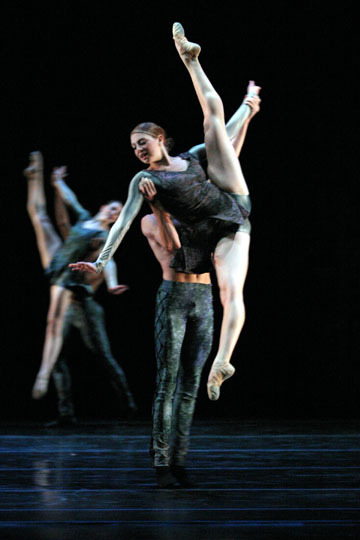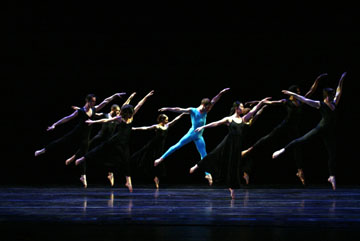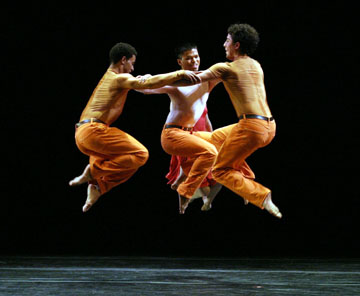Debussy, Brahms and Bach at Juilliard
Juilliard
Dances Repertory Edition 2004
Juilliard
Theater
New York, NY
March 26, 2004
By
Susan Reiter
copyright
© 2004 by Susan Reiter
published 12 April 2004
The Juilliard Theater Orchestra recently performed a varied and richly satisfying program of Debussy, Brahms and Bach—and the impressive sounds coming from the pit were not even the primary attraction. The annual showcase for Juilliard's dance students was a solid program of works from the past three decades by three established modern-dance choreographers with distinctive styles, one of them a true master.
In past years, these concerts used to include a ballet (or quasi-ballet) work by someone such as Hans van Manen or one of the faculty's ballet specialists, and at times ventured into original choreography by young choreographers, often with a Juilliard connection. Now that the Juilliard Dance Division, under the direction of Lawrence Rhodes, has instituted a December showcase for choreography created specifically for the students, this spring event allows them to find their way into works created for the company members who work regularly with choreographers.
 The
intensely supple shapes and twisting, fluid partnering of Nacho Duato's
1991 Duende (staged by Kim McCarthy) show him still working in
a style deeply influenced by Jiri Kylian in this early work. His response
to three sensual, languid Debussy chamber scores is movement that develops
in abrupt stops and starts. He takes yoga positions and adds surprising
punctuation marks to them, turns his dancers into insect-like creatures
of boneless pliability, and ask them to move with the same illusion of
well-oiled knee joints that Kylian often favors. One striking (and often
gasp-inducing) image followed another, and one could only be impressed
by Duato's ingenuity and the dancers' brave, wholehearted plunge into
his intricate moves. But there was little organic connection to the music.
One missed the sense that these movements sprang from Duato's personal,
instinctive response to Debussy. What remained once the work was over
was a series of vivid snapshots of vivid, often surprising moments (such
as the conclusion of a duet which found the woman suspended in an "angel
balance" on the upstretched legs of her prone partner, seeming to
lie on her back in the air) but not the satisfaction of a completed journey.
The
intensely supple shapes and twisting, fluid partnering of Nacho Duato's
1991 Duende (staged by Kim McCarthy) show him still working in
a style deeply influenced by Jiri Kylian in this early work. His response
to three sensual, languid Debussy chamber scores is movement that develops
in abrupt stops and starts. He takes yoga positions and adds surprising
punctuation marks to them, turns his dancers into insect-like creatures
of boneless pliability, and ask them to move with the same illusion of
well-oiled knee joints that Kylian often favors. One striking (and often
gasp-inducing) image followed another, and one could only be impressed
by Duato's ingenuity and the dancers' brave, wholehearted plunge into
his intricate moves. But there was little organic connection to the music.
One missed the sense that these movements sprang from Duato's personal,
instinctive response to Debussy. What remained once the work was over
was a series of vivid snapshots of vivid, often surprising moments (such
as the conclusion of a duet which found the woman suspended in an "angel
balance" on the upstretched legs of her prone partner, seeming to
lie on her back in the air) but not the satisfaction of a completed journey.
 The
roiling, onrushing opening of Lar Lubovitch's 1985 A Brahms Symphony
evokes a tidal wave along which are borne the four soloists, two men and
two women whose tropical-colored costumes make them stand out amid the
eight black-clad members of the ensemble. Lubovitch's movement (staged
here by company alumnae Peggy Baker and Rebecca Riegert) requires open
torsos and full-bodied dynamism, and the Juilliard cast was not as completely
conversant in his language as they were in Duato's; some of the backs
could have used more flexibility.
The
roiling, onrushing opening of Lar Lubovitch's 1985 A Brahms Symphony
evokes a tidal wave along which are borne the four soloists, two men and
two women whose tropical-colored costumes make them stand out amid the
eight black-clad members of the ensemble. Lubovitch's movement (staged
here by company alumnae Peggy Baker and Rebecca Riegert) requires open
torsos and full-bodied dynamism, and the Juilliard cast was not as completely
conversant in his language as they were in Duato's; some of the backs
could have used more flexibility.
The soloist roles were shaped around the qualities of four of Lubovitch's most distinctive company members: Christine Wright, Nancy Colahan, Rob Besserer and Doug Varone's most distinctive company members: Christine Wright, Nancy Colahan, Rob Besserer and Doug Varone. With Besserer himself in the house, it was difficult not to miss the heroic grandeur and peerless phrasing he brought to his role, although Anthony Smith, a less powerfully built, but vividly articulate dancer did quite well in the part. Cynthia Welik was notably expressive and spontaneous in Colahan's role.
 The
audience cheered effusively as the curtain went up on Paul Taylor's Esplanade,
as though greeting an old friend—or perhaps welcoming the one true
masterwork on the program. This version, staged by Taylor alumna and Juilliard
dance faulty member Linda Kent, restored the role of the woman in pink
(originally Carolyn Adams) to its rightful place. These days, the Taylor
company dances a version in which that role and the one of the woman in
red (Lila York in the original) have been to some extent combined. This
Juilliard staging made for a better balance between the female roles,
and allowed for more distinctive personlaities to emerge.
The
audience cheered effusively as the curtain went up on Paul Taylor's Esplanade,
as though greeting an old friend—or perhaps welcoming the one true
masterwork on the program. This version, staged by Taylor alumna and Juilliard
dance faulty member Linda Kent, restored the role of the woman in pink
(originally Carolyn Adams) to its rightful place. These days, the Taylor
company dances a version in which that role and the one of the woman in
red (Lila York in the original) have been to some extent combined. This
Juilliard staging made for a better balance between the female roles,
and allowed for more distinctive personlaities to emerge.
It also—thanks to the orchestra's crisp, energized performance of the Bach violin concertos—allowed one to appreciate anew how brilliantly and instinctively musical Taylor's choreography is. When the woman in red (Julia Boudreaux) jumps playfully over the reclining bodies of several others, each jump and skip punctuates a musical note. The hectic succession of women leaping into men's arms in the final movement was especially thrilling as one oculd feel the dancers playing off the music's energy.
The Juilliard cast gave an amiable, fresh reading of this timeless work, while not probing as deeply into its shifts of mood and hints of subtle relationships as one might find in a Taylor company performance. The first movement was not as natural; one missed the sense of carefree frolicking, and the enigmatic second movement did not resonate as deeply as it might. Still, this was a strong performance that closed the evening on a definite high note, and the nine dancers performing this unique choreography certainly have gained an invaluable learning experience.
Photos:
First: Juilliard Dance Ensemble members in "Duende" by choreographer
Nacho Duato; Photo by Rosalie O'Connor
Second: "Esplanade" by choreographer Paul Taylor; Dancers
(from L to R): Marcus Bellamy, Bennyroyce Royon, and Dario Mejia; Photo
by Rosalie O'Connor
Third: Juilliard Dance Ensemble members in "A Brahms Symphony";
coreographed by Lar Lubovitch. Photo by Rosalie O'Connor.
Originally
published:
www.danceviewtimes.com
Volume 2, Number 13
April 12, 2004
Copyright
©2004 by Susan Reiter
|
|